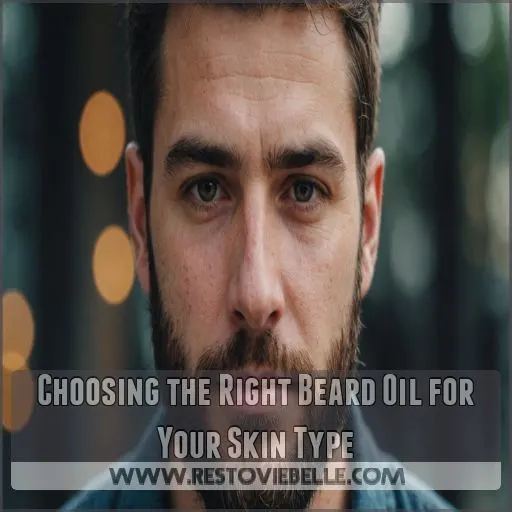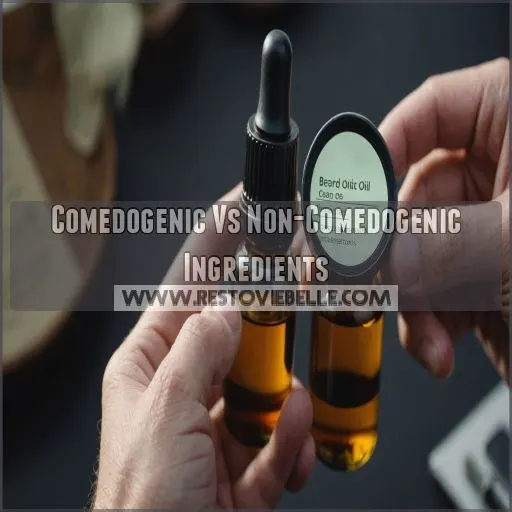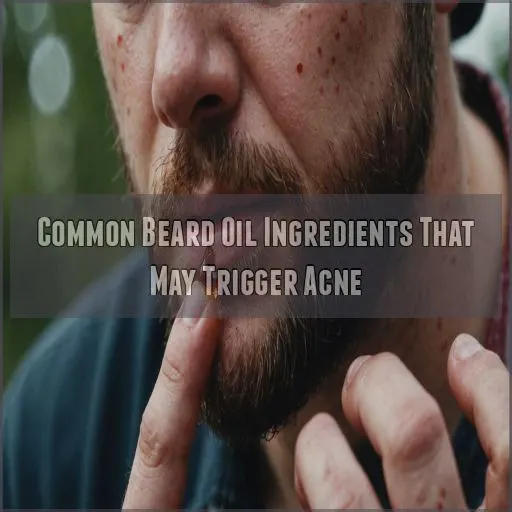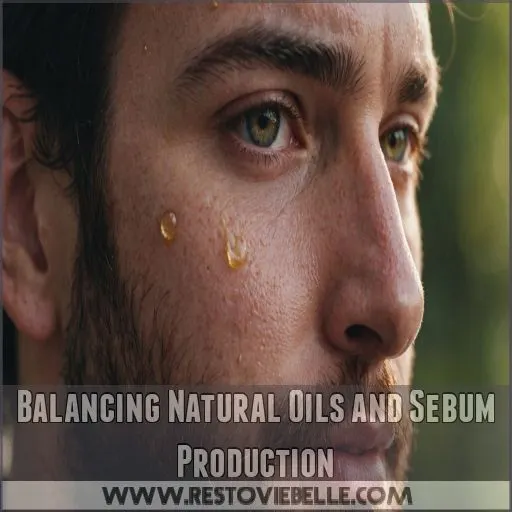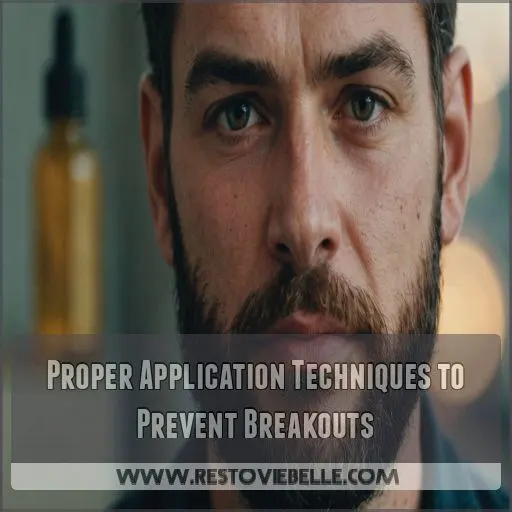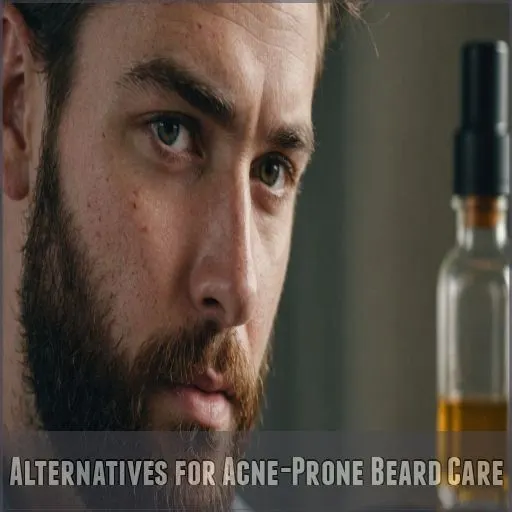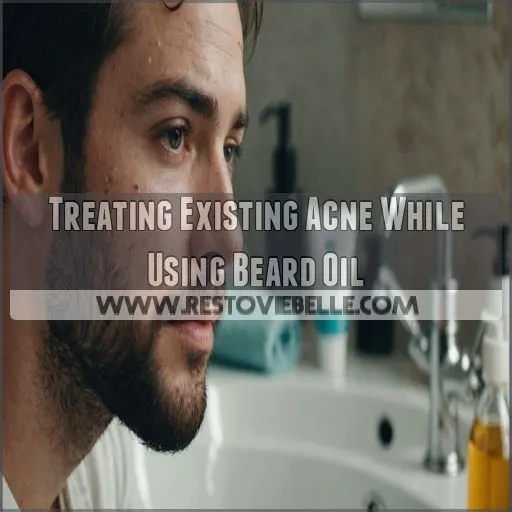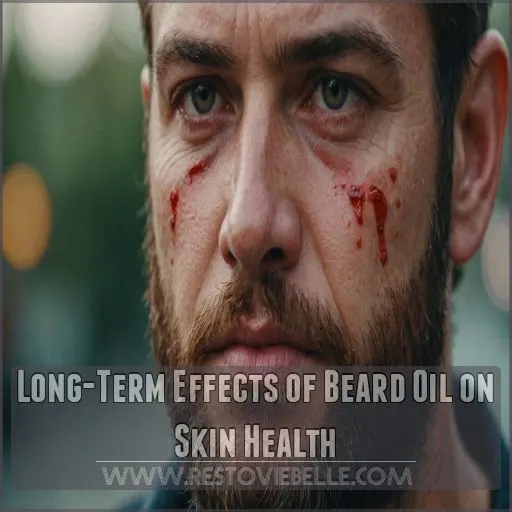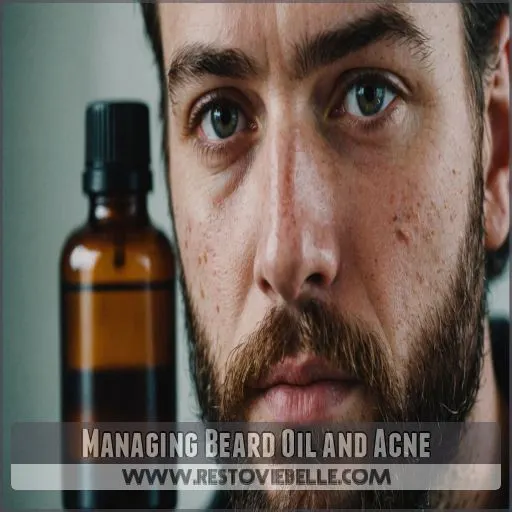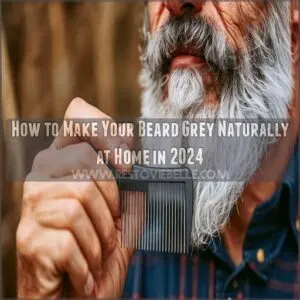This site is supported by our readers. We may earn a commission, at no cost to you, if you purchase through links.
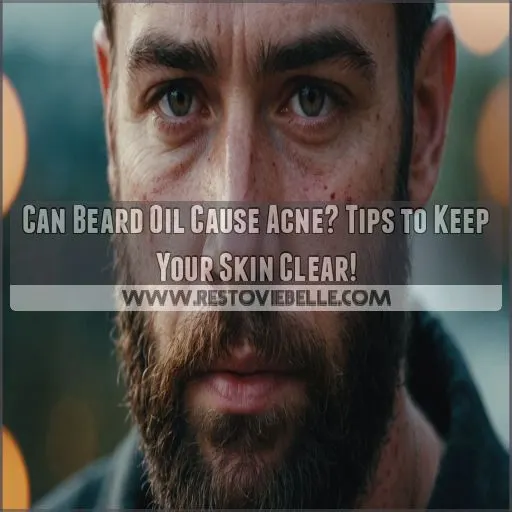
The culprit? Certain ingredients that love to clog your pores faster than you can say "breakout."
If you’ve got oily or sensitive skin, you’re playing on expert mode. But don’t toss that bottle just yet!
The key is choosing the right oil for your skin type and applying it like a pro. Too much of a good thing can turn your face into a greasy pizza. Stick around, and we’ll spill the secrets to keeping your beard luscious and your skin clear, and master the art of using beard oil.
Table Of Contents
- Key Takeaways
- Can Beard Oil Cause Acne?
- Choosing the Right Beard Oil for Your Skin Type
- Comedogenic Vs Non-Comedogenic Ingredients
- Common Beard Oil Ingredients That May Trigger Acne
- Balancing Natural Oils and Sebum Production
- Proper Application Techniques to Prevent Breakouts
- Alternatives for Acne-Prone Beard Care
- Treating Existing Acne While Using Beard Oil
- Long-Term Effects of Beard Oil on Skin Health
- Managing Beard Oil and Acne
- Frequently Asked Questions (FAQs)
- Can Beard oil cause acne?
- Does castor oil help with the growth of a beard?
- Why is my beard acne so bad?
- Can a beard cleanser cause acne?
- What beard oil doesn’t cause acne?
- What are the negatives of beard oil?
- What happens if I use beard oil everyday?
- Is there any side effects of using beard oil?
- How does testosterone affect beard growth and acne?
- Can certain beard oil ingredients worsen hormonal acne?
- Does beard length impact acne development?
- Are there genetic factors in beard-related acne?
- Can beard oil help with acne scars?
- Conclusion
Key Takeaways
- Keeping your beard luscious without causing acne is all about balance. Choose non-comedogenic oils, such as jojoba and argan, which won’t clog pores, and remember: less is more when applying.
- If you notice new breakouts after using beard oil, don’t panic. It might be time to switch to a beard-friendly product or even consult a dermatologist. Your skin will thank you for the attention.
- Application technique matters. Think of your beard as a tiny ecosystem. Cleanse before oiling, use just a few drops, and spread them evenly to avoid clogging your pores.
- For acne-prone individuals, consider alternatives like water-based beard moisturizers or lightweight serums. They will keep your beard smooth without adding to the pimple party.
Can Beard Oil Cause Acne?
You love your beard, but acne tagging along for the ride isn’t so charming!
Discover how beard oil could play a part in your skin troubles and make peace between your facial hair and complexion.
Understanding the Relationship Between Beard Oil and Acne
If you’ve noticed a sudden uptick in breakouts since starting to use beard oil, there may be a connection.
Beard oil can potentially clog pores and exacerbate acne, especially for those with sensitive or oily skin .
The key is finding a beard oil formulation that works harmoniously with your skin type.
How Certain Ingredients in Beard Oil Can Clog Pores
Choosing the right beard oil can feel like walking a tightrope, especially if you’re acne-prone.
Certain ingredients, like coconut and soybean oil, have a high comedogenic rating, meaning they can clog pores and trigger breakouts.
Oil absorption varies per skin type, so pay attention to ingredient research and your skin’s sensitivity to maintain control over your skincare routine .
Signs That Beard Oil May Be Causing Acne
Ever wondered if that new beard oil is backfiring? Here are signs it might be causing acne:
- Increased breakouts right after use.
- New pimples sprouting under your beard.
- Clogged pores leading to inflamed skin.
- Irritated beard and heightened oil production.
These could mean your skin’s crying out for a change—look for non-comedogenic options!
Choosing the Right Beard Oil for Your Skin Type
Choosing the right beard oil can help keep your skin happy and acne-free, even if it sometimes feels as tricky as picking the right socks for a blind date.
Pay attention to your skin’s sensitivity and don’t hesitate to chat with a dermatologist for advice—it’s like having a skincare GPS, guiding you through the jungle of beard care products.
When considering the right beard oil, think about a dermatologist for advice that can help you choose the right product based on your skin type.
Assessing Individual Skin Sensitivity
Choosing the right beard oil can feel like finding a needle in a haystack.
Keep your skin type front and center by patch testing new products. Look for signs of irritation, such as redness or itching, which could mean an ingredient doesn’t suit your skin.
Remember, what’s perfect for one person could be an acne trigger for another.
Stay observant and keep in mind that what’s perfect for one person is not always the case for someone else.
Consulting With Dermatologists for Personalized Advice
If you’re looking for the right beard oil for your skin, don’t go it alone – consult a dermatologist.
They can assess your unique skin type, pinpoint any sensitivities, and craft a personalized acne treatment plan to keep your complexion clear while maintaining that dashing beard.
Comedogenic Vs Non-Comedogenic Ingredients
When picking beard oil, understanding the comedogenic rating of its ingredients is really important to keeping breakouts at bay.
Think of it as choosing between a road that flows freely or one full of traffic jams; you want oils that won’t clog your skin’s pores, ensuring a road that flows freely.
Understanding the Comedogenic Rating of Beard Oil Ingredients
You’ve got your beard oil, but what’s lurking inside? Those pesky comedogenic ratings can spell acne trouble if you’re not careful. Here’s how to keep things clear:
- Check your oil’s comedogenic rating (0-5 scale).
- Avoid ingredients like coconut oil (rated 4).
- Look for oils with ratings 1 or below.
- Test small patches to make sure it’s safe.
Non-Comedogenic Beard Oil Ingredients for Clear Skin
Choosing the right beard oil can feel like a maze.
Opt for non-comedogenic oils like jojoba, grapeseed, or argan to keep your skin happy and clear. These oils hydrate without clogging pores.
| Oil Type | Benefit |
|---|---|
| Jojoba Oil | Light and fast-absorbing |
| Grapeseed Oil | Anti-inflammatory |
| Argan Oil | Deeply moisturizing |
A healthy skincare routine includes natural, oil-absorption-friendly ingredients!
Ingredients to Avoid in Beard Oil for Acne-Prone Skin
Clogging factors like comedogenic oils and silicones can be the sneak thieves in your beard oil, ready to pilfer skin clarity.
Avoid coconut oil, mineral oil, and synthetic fragrances—they’re like uninvited guests clogging pores on acne-prone skin. Watch out for parabens and drying alcohols too.
Opt for non-comedogenic ingredients to keep your skin smooth and unburdened.
Common Beard Oil Ingredients That May Trigger Acne
With beard oil, not all ingredients are created equal.
Certain oils like coconut, avocado, and soybean can clog pores and trigger breakouts, so it’s essential to read the label and choose a formula that won’t sabotage your skin.
Coconut Oil and Its Comedogenic Rating
Coconut oil can be a tricky customer for your skin.
With a comedogenic rating of 4, it’s like inviting a clingy friend to the party—risking clogged pores and acne .
While its moisturizing marvels sound tempting, consider alternative oils if your skin type prefers a more open-door policy.
Keep it light, keep it clear! .
Avocado Oils Impact on Acne-Prone Skin
Avocado oil might be your skin’s next best friend. Unlike coconut oil, it boasts a non-comedogenic rating, reducing the risk of clogged pores.
But keep an eye out for specific reactions:
- Check for signs of skin irritation.
- Observe oil absorption, as avocado oil can hydrate without greasiness.
- Monitor acne treatment effectiveness, ensuring healthy skin and minimal beard oil side effects.
Soybean Oil and Pore Clogging
While avocado oil might’ve been a mixed bag, soybean oil can raise eyebrows with its acne risk.
It’s got a comedogenic rating of 2, meaning it may clog facial pores and isn’t a friend to oily skin.
For better beard care, you might want to explore oil alternatives that won’t turn your face into a breakout battleground.
Flaxseed Oils Effects on Facial Skin
Now, let’s uncover the effects of flaxseed oil on your facial skin—flaxseed oil offers anti-inflammatory benefits, potentially soothing dry, irritated skin.
But be cautious! In acne-prone individuals, its large molecules might just sit on the surface, possibly clogging pores and inviting blemishes.
Adding flaxseed oil to your beard care routine could be a mixed bag, as it may have both positive and negative effects, including potentially soothing dry, irritated skin.
Marula Oil and Acne Concerns
Marula oil may not be the miracle cure for acne-prone skin that some claim.
While it has antioxidant and anti-inflammatory benefits, its high oleic acid content can potentially clog pores and exacerbate breakouts.
If you have oily or blemish-prone skin, consider non-comedogenic alternatives like jojoba or tea tree oil instead.
Balancing Natural Oils and Sebum Production
Balancing your skin’s natural oils and sebum is key to a clear complexion while using beard oil.
Think of it as finding the perfect pizza-to-cheese ratio—too much of either can lead to a breakout!
Understanding Skins Natural Oil Production
Sebum production is your skin’s natural way of keeping things smooth and healthy.
Think of sebum as argan oil or cocoa butter for your complexion—it moisturizes and protects (Source).
Hormones and individual skin type can impact oil balance, sometimes leading to acne.
Understanding this helps you choose the right beard oil, like sweet almond or grapeseed oil, to maintain skin health and find a balance with your natural sebum production.
How Beard Oil Affects Sebum Balance
When you’re trying to grow the perfect beard, understanding how beard oil affects sebum balance is really important.
Beard oil can moisturize and protect, but finding the right balance is key. Using pore-clogging ingredients like cocoa butter ingredients or applying the wrong oil ratio might lead to acne, as it disrupts the natural balance of the skin.
Sebum production varies by skin type, so you need to choose a beard moisturizer that suits your skin.
Focus on balance to keep your skin healthy.
Optimal Oil Ratios for Acne-Prone Skin
Finding the best oil ratios for acne-prone skin is like creating a magic potion for your face.
Jojoba oil, with its non-comedogenic properties, becomes your trusty sidekick, while cedarwood and lavender essential oils act as calming agents.
Avoid heavy oils like coconut, and instead, whip up a DIY recipe that respects your skin’s sensitivity and balances sebum without causing breakouts , making it a suitable choice for acne-prone skin.
Proper Application Techniques to Prevent Breakouts
Applying beard oil correctly can prevent acne breakouts and keep your skin happy and healthy.
By following a few straightforward steps, you can enjoy a well-groomed beard without turning it into an unwelcome pimple party.
Cleansing Before Beard Oil Application
Before applying beard oil, start with a solid cleansing routine. Think of it this way: your beard’s a garden, and you want to plant the oil seeds on fresh soil.
- Wash with a beard wash to remove dirt.
- Exfoliate gently to cleanse pores.
- Rinse with warm water for open pores.
- Pat dry; no dripping!
Healthy beard, here you come!
Correct Amount of Oil to Use
The amount of beard oil you use matters.
Too much can clog pores and cause breakouts.
Start with just a few drops, warming it in your palms before applying evenly from roots to tips.
Adjust the amount based on your beard length and skin sensitivity.
A little goes a long way, with the right amount being key to a healthy beard.
Even Distribution Throughout the Beard
To achieve even beard coverage, try this simple trick: rub a few drops of beard oil in your hands and massage it thoroughly into your skin first.
Then, employ a downward motion from your cheeks, continuing through your beard’s length.
Don’t ignore the underside—cup the beard from beneath to make sure consistent distribution and absorption for that silky smooth finish.
Frequency of Application for Acne-Prone Skin
You’ve got your beard oil evenly spread, but how often should you use it on acne-prone skin?
Start by applying it once daily. Consider your skin type and oil absorption: if breakouts increase, reduce application.
Longer beards might need a bit more, while shorter ones could get by with just a drop. It’s like finding the perfect coffee strength—personalized just for you!
Avoiding Over-Application and Residue Build-up
Think of beard oil as a friendship with your skin—too much attention can smother.
Over-applying beard oil can lead to residue and buildup, risking clogged pores like a kitchen sink.
Stick to a few drops for that sweet spot of moisture without blockage.
Pair this with a regular cleansing routine to keep your face fresh and breakouts at bay .
Alternatives for Acne-Prone Beard Care
If you’re worried about acne but still want to keep that beard looking sharp, don’t fret.
There are alternatives like water-based beard moisturizers and lightweight serums that can keep your skin clear without triggering breakouts.
Your face will thank you for using water-based beard moisturizers and lightweight serums.
Water-Based Beard Moisturizers
Before you grab that oily bottle, consider water-based beard moisturizers. They offer hydration without heavy oils, making them a savior for acne-prone skin. You won’t feel greasy, and your beard stays soft and happy.
Keep in mind:
- Hydration: Water-based moisturizers are great for dry beards.
- Lightweight: Feel fresh, not weighed down.
- Sensitive Skin Friendly: Gentle on acne-prone skin.
Lightweight Beard Serums
Ditch heavy oils and grab a lightweight beard serum to keep your acne-prone skin in check.
With its feather-light touch, it helps moisturize without clogging pores, just like magic.
Look for serums with soothing ingredients and a lightweight texture. Apply a few drops, massage gently, and you’re good to go.
DIY recipes offer personalization, ensuring control and safety.
Natural Beard Balms With Non-Comedogenic Ingredients
Instead, consider trying a natural beard balm with non-comedogenic ingredients.
These balms can help tame flyaways, add shine, and moisturize without clogging pores.
Look for balms containing shea butter, jojoba oil, and beeswax – they provide hold and nourishment without the acne-triggering properties of some beard oils.
DIY Acne-Safe Beard Oil Recipes
Creating acne-safe DIY beard oil is a cinch with natural ingredients like jojoba and grapeseed oils.
These non-comedogenic carrier oils pair brilliantly with essential oils like tea tree and lavender for a soothing, personalized blend.
You’ll keep skin clear without breaking the bank. Whip up your concoction in minutes and say goodbye to pesky beard acne (Source).
Treating Existing Acne While Using Beard Oil
If you’re battling acne while trying to maintain a luscious beard, don’t fret—there are effective strategies to manage both.
By strategically using spot treatments, gentle exfoliation, and maintaining a consistent cleansing routine, you can keep your skin clear and your beard looking great.
Using Benzoyl Peroxide for Spot Treatment
Benzoyl peroxide can be your beard’s acne-fighting superhero. This powerful ingredient effectively targets and kills acne-causing bacteria (Source).
When using it for spot treatment, apply a thin layer directly to problem areas, avoiding your beard hair. Start with a lower concentration (2.5%) to minimize irritation.
It’s a game-changer for many, but patience is key – results may take a few weeks. Remember, benzoyl peroxide can bleach fabrics, so be cautious with your pillowcases and towels.
Gentle Exfoliation Techniques for Bearded Skin
Taming that forest on your face? Don’t forget to gently exfoliate!
You’ll want to use a soft brush or scrub to clear away dead skin cells and prevent ingrown hairs .
Aim for about three times a week, using a gentle physical exfoliant like a microfoliant.
Just remember, timing is key – exfoliate on your non-shaving days to avoid irritation.
Your beard (and skin) will thank you!
Importance of Consistent Cleansing Routine
A consistent cleansing routine is the cornerstone of healthy beard care and acne prevention. Don’t let your facial fuzz become a breeding ground for bacteria!
- Wash your face (and beard) twice daily with a gentle cleanser
- Use lukewarm water to avoid irritation
- Pat dry gently, don’t rub
Remember, your beard isn’t a shield against acne – it needs just as much TLC as the rest of your face!
Long-Term Effects of Beard Oil on Skin Health
You might be wondering about the long-term effects of beard oil on your skin health.
Let’s take a look at how this popular grooming product can impact your skin over time.
From potentially improving your skin barrier to influencing your skin’s microbiome.
Potential for Improved Skin Barrier Function
Beard oil might be your skin’s secret weapon, enhancing skin barrier health while promoting healthy beard growth.
Many oils boast anti-inflammatory and antioxidant properties that help shield your skin from dryness and environmental stressors, providing a much-needed solution for dry skin.
When integrated into your skincare routine, beard oil can be a trusty companion on your journey to refreshed, balanced skin .
Risk of Chronic Pore Congestion
While beard oil can improve your skin’s barrier function, it’s not all smooth sailing.
Long-term use of comedogenic products may lead to chronic pore congestion . Think of your pores as tiny traffic jams – the wrong oils can clog them up, potentially causing persistent acne.
To keep your skin clear, opt for non-comedogenic oils that won’t block your pores. Your face will thank you for the smoother ride!
Changes in Skin Microbiome
Your skin’s microbiome is like a bustling city of tiny organisms. Regular beard oil use can shake things up, potentially altering this delicate ecosystem.
- Shifts in bacterial populations
- Changes in pH levels
- Altered sebum production
- Potential for overgrowth of certain microbes
Remember, everyone’s skin is unique. What works for your buddy might turn your face into a microbial battleground. Keep an eye on how your skin responds to beard oil and adjust accordingly.
Impact on Long-Term Acne Management
Three key factors influence how beard oil impacts your long-term acne management.
First, consistent use can improve your skin’s barrier function, potentially reducing breakouts.
However, be cautious – some oils might lead to chronic pore congestion if not suited to your skin type.
Finally, beard oil can alter your skin’s microbiome, affecting its natural balance.
To keep your skin clear, it’s vital to choose the right oil and adjust your skincare routine accordingly.
Managing Beard Oil and Acne
Worried your beard oil might be causing breakouts? Let’s explore how to balance your facial hair care routine with keeping your skin clear and healthy.
Adjusting Beard Oil Application Based on Skin Type
Tailoring your beard oil routine to your skin type is key for keeping acne at bay. Think of it like finding the perfect dance partner – you need the right moves and rhythm.
- Oily skin: Use lighter oils and apply less frequently
- Dry skin: Opt for richer oils and apply more often
- Sensitive skin: Choose fragrance-free options and patch test
- Combination skin: Focus oil on drier areas, avoiding oily zones
Remember, it’s all about finding your skin’s sweet spot!
Frequently Asked Questions (FAQs)
Can Beard oil cause acne?
Beard oil doesn’t directly cause acne, but it can contribute to breakouts if you’re prone to them.
Choose lightweight, non-comedogenic oils. Apply sparingly to avoid clogging pores.
Your skin’s sensitivity matters; patch-test new products first.
Does castor oil help with the growth of a beard?
While castor oil’s benefits for beard growth aren’t definitively proven, it may indirectly help by protecting follicles and improving skin health.
You’ll likely see more results from consistent grooming habits and a healthy lifestyle than from castor oil alone.
Why is my beard acne so bad?
Your beard’s acting up?
It’s likely a cocktail of culprits: trapped oil, dead skin, and bacteria.
You’re not alone – poor hygiene, over-oiling, and even your pillowcase can be accomplices.
Time to shake up your grooming routine!
Can a beard cleanser cause acne?
Typically, a proper beard cleanser shouldn’t cause acne. However, if it’s too harsh or leaves residue, it might clog pores or irritate your skin.
Stick to gentle, non-comedogenic formulas and rinse thoroughly to keep your beard zone clear.
What beard oil doesn’t cause acne?
Imagine your beard as a garden.
Non-comedogenic oils are like gentle rain, nourishing without flooding.
Choose oils like jojoba, grapeseed, or argan.
They’ll keep your facial forest thriving without turning it into a breeding ground for pesky pimples.
What are the negatives of beard oil?
While beard oil can work wonders, it’s not without drawbacks.
You might face allergic reactions, skin inflammation, or clogged pores if you overuse it.
Some oils can even make your skin more sensitive to sunlight.
What happens if I use beard oil everyday?
You’ll be sitting pretty if you use beard oil daily. It’ll moisturize your skin and beard, reducing itchiness and dandruff .
But watch out: potential allergic reactions or breakouts may occur if you’ve got sensitive or acne-prone skin.
Is there any side effects of using beard oil?
Beard oil can have side effects.
You might experience allergic reactions, skin irritation, or breakouts if you’re sensitive to certain ingredients.
It’s best to patch test and choose oils that won’t clog your pores.
How does testosterone affect beard growth and acne?
Testosterone plays a dual role in your facial hair journey.
It boosts beard growth, giving you that rugged look, but it’s also the culprit behind pesky acne.
Your body converts about 10% of testosterone into DHT daily.
Can certain beard oil ingredients worsen hormonal acne?
Certain beard oil ingredients can indeed exacerbate hormonal acne.
Watch out for comedogenic oils that might clog your pores.
Opt for lightweight options like jojoba or argan oil, which hydrate without greasing up your skin . It’s a delicate balancing act!
Does beard length impact acne development?
While longer beards can trap more dirt and oil, length itself doesn’t directly cause acne.
You’re more likely to develop breakouts from poor hygiene or irritation.
Keep your beard clean and well-groomed to minimize acne risk .
Are there genetic factors in beard-related acne?
Yes, genetic factors play a role in beard-related acne.
Your DNA influences androgen levels and sebaceous gland activity, which can affect acne development.
It’s like your genes are rolling the dice for your skin’s future!
Genetic predisposition and androgen levels can be key factors in how acne develops.
Can beard oil help with acne scars?
Beard oil can potentially help with acne scars by moisturizing and nourishing your skin.
Tea tree oil, found in some beard oils, may reduce the appearance of scars over time .
However, results can vary between individuals.
Conclusion
Choosing the right beard oil can feel like threading a needle with boxing gloves on.
But fear not, bearded warriors! Armed with knowledge about ingredients, application techniques, and your skin type, you can confidently use beard oil without triggering acne.
Remember, can beard oil cause acne? Yes, but it’s not inevitable. Listen to your skin, choose wisely, and apply sparingly.
With these tips in your grooming arsenal, you’ll rock a luscious beard and clear skin. Now go forth and conquer the world, one well-oiled whisker at a time!

